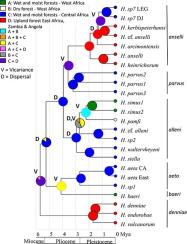当前位置:
X-MOL 学术
›
Mol. Phylogenet. Evol.
›
论文详情
Our official English website, www.x-mol.net, welcomes your
feedback! (Note: you will need to create a separate account there.)
The phylogeny of the African wood mice (Muridae, Hylomyscus) based on complete mitochondrial genomes and five nuclear genes reveals their evolutionary history and undescribed diversity.
Molecular Phylogenetics and Evolution ( IF 3.6 ) Pub Date : 2019-12-06 , DOI: 10.1016/j.ympev.2019.106703 Violaine Nicolas 1 , Pierre-Henri Fabre 2 , Josef Bryja 3 , Christiane Denys 1 , Erik Verheyen 4 , Alain Didier Missoup 5 , Ayodeji Olayemi 6 , Pionus Katuala 7 , Akaibe Dudu 7 , Marc Colyn 8 , Julian Kerbis Peterhans 9 , Terrence Demos 10
Molecular Phylogenetics and Evolution ( IF 3.6 ) Pub Date : 2019-12-06 , DOI: 10.1016/j.ympev.2019.106703 Violaine Nicolas 1 , Pierre-Henri Fabre 2 , Josef Bryja 3 , Christiane Denys 1 , Erik Verheyen 4 , Alain Didier Missoup 5 , Ayodeji Olayemi 6 , Pionus Katuala 7 , Akaibe Dudu 7 , Marc Colyn 8 , Julian Kerbis Peterhans 9 , Terrence Demos 10
Affiliation

|
Wood mice of the genus Hylomyscus, are small-sized rodents widely distributed in lowland and montane rainforests in tropical Africa, where they can be locally abundant. Recent morphological and molecular studies have increased the number of recognized species from 8 to 18 during the last 15 years. We used complete mitochondrial genomes and five nuclear genes to infer the number of candidate species within this genus and depict its evolutionary history. In terms of gene sampling and geographical and taxonomic coverage, this is the most comprehensive review of the genus Hylomyscus to date. The six species groups (aeta, alleni, anselli, baeri, denniae and parvus) defined on morphological grounds are monophyletic. Species delimitation analyses highlight undescribed diversity within this genus: perhaps up to 10 taxa need description or elevation from synonymy, pending review of type specimens. Our divergence dating and biogeographical analyses show that diversification of the genus occurred after the end of the Miocene and is closely linked to the history of the African forest. The formation of the Rift Valley combined with the declining global temperatures during the Late Miocene caused the fragmentation of the forests and explains the first split between the denniae group and remaining lineages. Subsequently, periods of increased climatic instability during Plio-Pleistocene probably resulted in elevated diversification in both lowland and montane forest taxa.
中文翻译:

基于完整的线粒体基因组和五个核基因的非洲木鼠(Muridae,Hylomyscus)的系统发育揭示了它们的进化历史和未描述的多样性。
Hylomyscus属的木鼠是小型啮齿动物,广泛分布在热带非洲的低地和山地雨林中,它们在当地很丰富。最近的形态和分子研究在过去15年中将公认的物种数量从8种增加到18种。我们使用了完整的线粒体基因组和五个核基因来推断该属中候选物种的数量并描述其进化历史。在基因采样以及地理和生物分类学方面,这是迄今为止对幽门螺杆菌属的最全面的综述。根据形态学基础定义的六个物种组(aeta,alleni,anselli,baeri,denniae和parvus)是单系的。物种定界分析突出了该属中未描述的多样性:可能需要多达10个分类单元的描述或同义词的提升,以待类型标本的审查。我们的分歧测年和生物地理分析表明,中新世结束后,该属发生了多样化,并且与非洲森林的历史紧密相关。裂谷的形成与中新世晚期全球温度的下降共同导致了森林的破碎,并解释了丹尼亚组和其余世系之间的第一次分裂。随后,上新世期间气候不稳定的时期增加,可能导致低地和山地森林分类单元的多样性增加。我们的分歧测年和生物地理分析表明,中新世结束后,该属发生了多样化,并且与非洲森林的历史紧密相关。裂谷的形成与中新世晚期全球温度的下降共同导致了森林的破碎,并解释了丹尼亚组和其余世系之间的第一次分裂。随后,上新世期间气候不稳定的时期增加,可能导致低地和山地森林分类单元的多样性增加。我们的分歧测年和生物地理分析表明,中新世结束后,该属发生了多样化,并且与非洲森林的历史紧密相关。裂谷的形成与中新世晚期全球温度的下降共同导致了森林的破碎,并解释了丹尼亚组和其余世系之间的第一次分裂。随后,上新世期间气候不稳定的时期增加,可能导致低地和山地森林分类单元的多样性增加。
更新日期:2019-12-06
中文翻译:

基于完整的线粒体基因组和五个核基因的非洲木鼠(Muridae,Hylomyscus)的系统发育揭示了它们的进化历史和未描述的多样性。
Hylomyscus属的木鼠是小型啮齿动物,广泛分布在热带非洲的低地和山地雨林中,它们在当地很丰富。最近的形态和分子研究在过去15年中将公认的物种数量从8种增加到18种。我们使用了完整的线粒体基因组和五个核基因来推断该属中候选物种的数量并描述其进化历史。在基因采样以及地理和生物分类学方面,这是迄今为止对幽门螺杆菌属的最全面的综述。根据形态学基础定义的六个物种组(aeta,alleni,anselli,baeri,denniae和parvus)是单系的。物种定界分析突出了该属中未描述的多样性:可能需要多达10个分类单元的描述或同义词的提升,以待类型标本的审查。我们的分歧测年和生物地理分析表明,中新世结束后,该属发生了多样化,并且与非洲森林的历史紧密相关。裂谷的形成与中新世晚期全球温度的下降共同导致了森林的破碎,并解释了丹尼亚组和其余世系之间的第一次分裂。随后,上新世期间气候不稳定的时期增加,可能导致低地和山地森林分类单元的多样性增加。我们的分歧测年和生物地理分析表明,中新世结束后,该属发生了多样化,并且与非洲森林的历史紧密相关。裂谷的形成与中新世晚期全球温度的下降共同导致了森林的破碎,并解释了丹尼亚组和其余世系之间的第一次分裂。随后,上新世期间气候不稳定的时期增加,可能导致低地和山地森林分类单元的多样性增加。我们的分歧测年和生物地理分析表明,中新世结束后,该属发生了多样化,并且与非洲森林的历史紧密相关。裂谷的形成与中新世晚期全球温度的下降共同导致了森林的破碎,并解释了丹尼亚组和其余世系之间的第一次分裂。随后,上新世期间气候不稳定的时期增加,可能导致低地和山地森林分类单元的多样性增加。









































 京公网安备 11010802027423号
京公网安备 11010802027423号